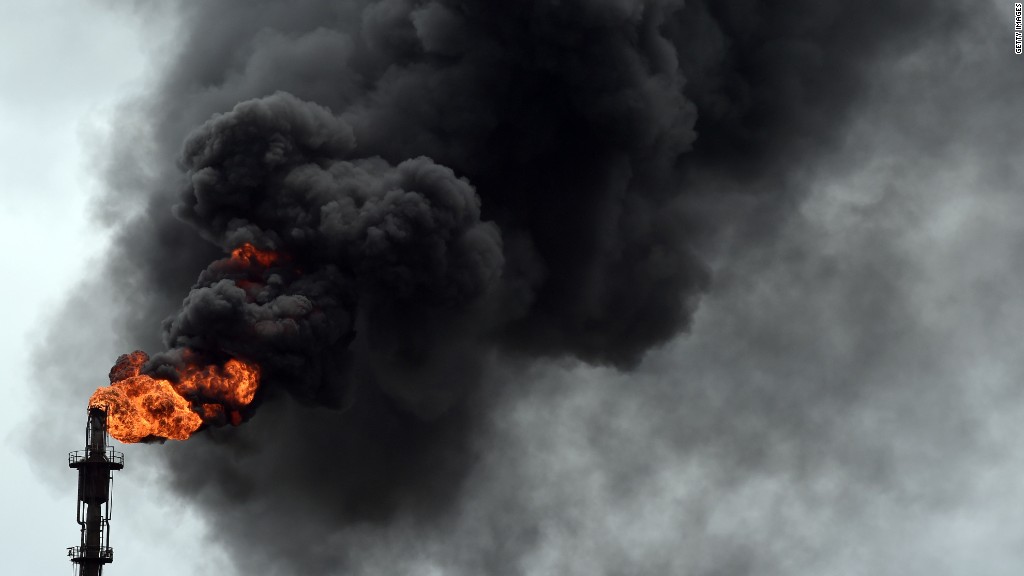
Big Oil didn't get invited to this year's Trump party on Wall Street.
Even though President Trump is unabashedly pro-oil, the fossil fuel industry is once again under serious pressure. Oil stocks are drowning in a sea of cheap crude prices, which tumbled this week to a five-month low.
Six of the S&P 500's bottom 10 stocks this year are in the oil business, led by 25% plunges from Transocean (RIG), Hess (HES) and Anadarko Petroleum (APC).
Crude prices rebounded by more than 2% on Friday, but the energy sector remains the worst-performing group of the S&P 500. It's down 11% in 2017, a year that has otherwise been a strong one for the stock market.
The oil slump marks yet another reversal in the notoriously boom-to-bust industry. Wall Street piled back into oil stocks late last year as crude prices seemed to stabilize and OPEC's willingness to finally cut production fueled hopes of higher prices to come.
But the long-awaited "rebalancing" of the oversupplied oil market hasn't really happened, largely due to resurgent supply from US shale producers. Crude plummeted as low as $43.76 a barrel early on Friday, touching the lowest level since the OPEC supply cut in late November.
"When oil prices are rising quickly, investors are afraid of missing out so they pile in. But when there's a sign of weakness like now, a lot of people bail," said Brian Youngberg, senior energy analyst at Edward Jones.
Even Big Oil stalwarts are feeling the pain. Chevron (CVX) and ExxonMobil (XOM) are the second and third-worst performers on the Dow this year, trailing only Verizon.
Related: Oil drops below $45 for 1st time since OPEC deal
The commodity slide has been driven by a myriad of factors, but it's led by renewed concern that strong output from US shale producers in the Permian Basin and elsewhere will deepen the glut. Many analysts are predicting the surprisingly-strong shale rebound will lift the US to record output in 2018.
Investors have been caught off guard by the technological innovations and balance sheet improvements that have allowed shale to be competitive at prices that were once far too low.
There is "growing evidence of the ability of US shale to respond near $50/barrel and the availability of capital to support such activity," Goldman Sachs strategists wrote in a report on Friday.
In fact, a number of American shale producers have recently signaled more output is coming as they focus on the most lucrative US shale plays.
Take Marathon Oil (MRO), for instance. On Friday, Marathon said that following its recent exit from the Canadian oil sands, 95% of its spending budget is devoted to US shale. Marathon also raised its forecast for 2018 output.
"Many shale producers are increasing their production guidance. That is spooking a lot of people that shale will offset the OPEC cuts," said Youngberg.
In other words, US shale is threatening to further delay the rebalancing process.
Related: Saudis take 100% control largest US oil refinery
Besides excess supply, oil has been dragged down by surprisingly-weak US demand for gasoline. Analysts have struggled to explain the demand drop-off, but they point to the fact that gasoline prices are up from early 2016's very low levels and that new cars continue to guzzle less gas.
Some on Wall Street are concerned the oil trouble will spell trouble for other parts of the market and economy. That's what happened in early 2016 when oil prices briefly crashed to $26 a barrel.
"Can oil derail the whole market? I often worry when there are large outlier moves in markets, and this oil move is looking like one," Michael Block, chief market strategist at Rhino Trading, wrote in report to clients.
So far, that doesn't look like the case. The Dow is flat this week, despite crude prices crashing 6%.
Regardless, shareholders in oil companies hope that Friday's rebound for crude prices marks the beginning of a turnaround.
Many analysts express confidence that oil prices will eventually head higher, because that's what is needed to attract new investment. Without that investment, there could be supply shortages in the future.
"The industry cannot survive on $50 or below oil prices over time," said Youngberg. "From here we see upside. Investors just need to very patient and tolerant of the volatility. That's a challenge."


